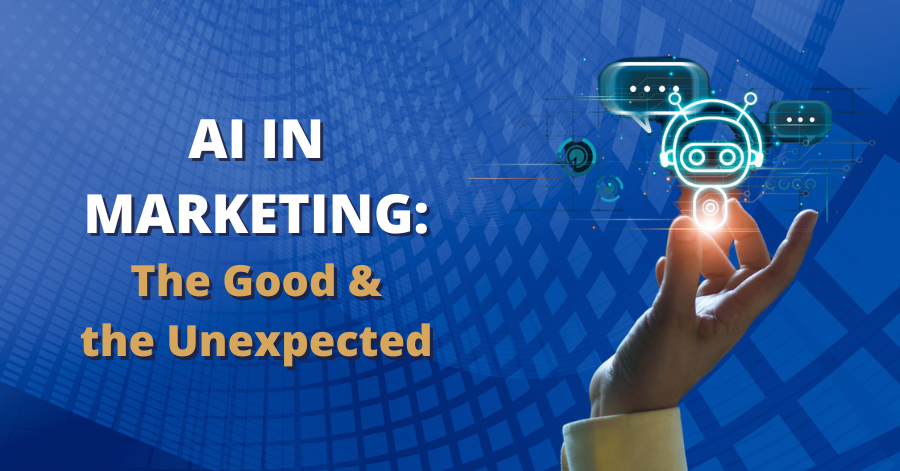
AI in marketing is no longer a futuristic concept; it’s a powerful tool actively transforming how we connect with audiences through AI in marketing. In fact, a significant 64% of marketers report that content generated with AI in marketing performs as well as or even better than traditional methods. This increasing success of AI in marketing is fueled by its ability to boost efficiency, scale content creation, and reduce costs using AI in marketing strategies.
Generative AI has taken the world by storm. Each new development brings new possibilities so rapidly that reporting on them as they occur is a full-time job. Every industry wants to know what AI can do and how they can best incorporate it into their offerings. And in the marketing world, those questions are especially interesting.
Artificial intelligence has the potential to change our marketing approach fundamentally. While many of these changes appear promising, it also creates new challenges. The question is no longer if you should incorporate generative AI. Rather, it’s how your company can best use AI in marketing now and following future developments. Let’s explore how you can effectively integrate AI in marketing to elevate your strategies and achieve more impactful results.

Utilizing AI in marketing for idea generation can spark creativity and innovation within teams. Furthermore, AI in marketing can help optimize email campaigns, ensuring higher engagement rates.
Idea Generation & Brainstorming
By leveraging AI in marketing analytics, brands can tailor their messages to suit specific customer segments more effectively. AI in marketing ensures that your strategies are data-driven, giving you a competitive edge. AI in marketing helps personalize customer experiences, increasing engagement and loyalty.
For marketers, AI in marketing can be a powerful tool for idea generation. An AI can help your marketing team brainstorm content topics, assemble outlines, or even edit the tone of an article you give it. The AI can’t (and shouldn’t) write for you. However, it can give you valuable suggestions to improve the material you’ve already written using AI in marketing tools. Incorporating AI in marketing can also help analyze customer behavior at scale, leading to better product recommendations.
AI in marketing can facilitate real-time engagement, ensuring your brand stays connected with customers. An AI can also perform data analysis to help with future marketing efforts. For instance, having an AI look over your most recent email marketing campaign might highlight suggestions for getting more clicks. This lets your marketing team explore options to test and refine upcoming campaigns accordingly.
A human might not notice this pattern immediately, but an AI can quickly review the data and identify trends. An AI marketing tool can also sift through past company data, competitor campaigns, and even industry trends to see what’s worked in the past and what might work in the future. This proactive approach helps your marketing team move beyond relevance into pioneering.
Market Segmentation & Social Listening
One of AI’s most valuable contributions to marketing is its ability to analyze social media data at an unprecedented scale. An AI can examine your company’s social media posts and interactions to identify critical patterns. Automating routine tasks with AI in marketing allows your team to focus on more strategic initiatives.
Much like the email marketing example, this kind of data analysis tells your team what works and for what customer segments. This kind of segmentation doesn’t have to stop with social media, either. Emails, text messages, and other marketing communications could benefit from a quick AI analysis to determine what’s working. AI in marketing is a powerful ally in data analysis, transforming raw data into actionable insights.
Personalization & Engagement
AI in marketing can significantly increase efficiency, allowing for faster decision-making and campaign adjustments. By using AI in marketing, brands can quickly adapt to market trends and consumer preferences. AI in marketing provides insights that can lead to more effective campaign strategies. AI in marketing can enhance predictive analytics, enabling businesses to forecast customer behavior accurately. Customer interests shift—and so will their purchases from you. If you can’t keep up with what they want using AI in marketing, they might lose interest and look elsewhere.
Incorporating AI in marketing allows for the creation of customer profiles that improve targeting efforts. AI in marketing helps uncover insights that drive better product development and service offerings. Moreover, AI in marketing can streamline processes, making it easier for teams to focus on high-value activities. Understanding AI in marketing is crucial for any business looking to thrive in the digital age. Marketers must remain cautious while adopting AI in marketing, ensuring ethical practices are followed.
This is where an AI can help. With a detailed analysis of past customer behavior and preferences, your AI can suggest products or services a customer is more likely to be interested in. This can extend to offering discounts or promotions to re-engage inactive contacts or keep current ones interested. An AI can even identify the optimal time and communication method to reach a specific person.
Finally, AI can also facilitate real-time engagement with customers through chatbots. An AI-powered chat function on your website can provide instant customer support and address FAQs. Make sure that these AI-powered tools hand the conversation over to a human representative if more complex or sensitive matters arise.
Overestimating AI in marketing can lead to unrealistic expectations and potential setbacks. Balancing the use of AI in marketing with human creativity is essential for successful outcomes. Proper supervision of AI in marketing tools is vital to ensure they meet evolving business needs.

Busywork
Some AI systems can even use a computer the way a human would to handle manual tasks. One example is Claude, a group of LLMs that is currently learning how to perform simple computer commands. The developers provide an example: telling Claude to fill out a form online using data stored on the user’s computer. Claude would interpret these instructions as individual steps. It checks the indicated file containing the data, moves the mouse to click on a web browser, opens the required webpage, and fills in the form using the provided data. As of November 2024, Claude cannot reliably complete tasks like this. However, the developers are working on solutions to make it possible.
AI Data Analysis: A Huge Time Saver
Marketing involves collecting, sorting, and using a lot of data, especially when leveraging AI in marketing. What exactly this data is used for varies. However, one thing holds true: raw data is not particularly useful. The collected data must be examined, refined, interpreted, and connected to other information to boost your marketing efforts.
Recent AI developments show promise in making this data more accessible, especially for those less experienced with complex analytics software. In fact, a significant 79% of marketers identify increased efficiency as a top benefit of adopting AI, highlighting its power to rapidly process and analyze marketing data.
What Can AI-Driven Data Analysis Do?
An AI can read a detailed spreadsheet of data in seconds. The tool can then assist with several key marketing functions that offer particular value. First, an AI can perform a rapid quality check on your data and confirm if it’s accurate and usable. An AI can also highlight any potential errors or instances of anomalous or “dirty data” to remove and suggest improvements for future data collection.
Second, AI-assisted data analysis allows for detailed predictive analytics to be developed much faster than before, and compare the results with industry benchmarks. This allows your team to more accurately guess which direction the market may be going and what consumers will want in the near future. This leads to better decision-making that’s far more likely to capture and retain customer interest. It also saves precious time, allowing your team to be among the first to identify and capitalize on an upcoming trend.
Third, AI-driven customer data analysis allows for increased personalization. An AI tool can make connections or inferences from data points that a human might miss. It can also consider every minute piece of information, even things that might not seem immediately helpful. The result? Your marketing team can explore and construct more detailed customer profiles and create content that speaks directly to a customer’s pain points.
Finally, AI can simply uncover new insights from collected data that aren’t readily apparent, even things some expert data analysis might overlook. If you understand what the data contains but aren’t sure how to narrow it down to what you want, an AI can be an excellent tool.
Remember: while AI-driven data analysis offers valuable help to marketers who aren’t experts, the results still require human review and validation. AI still makes plenty of mistakes. Your data analytics expert can help locate and fix errors in the AI’s results.
AI in Marketing: What Not to Do
While AI offers significant advantages, its adoption isn’t without hurdles. A recent survey highlights that marketers face several barriers, with data privacy concerns being the most prominent at 40.44%. Additionally, lack of technical expertise (37.98%) and the cost of implementation (33.17%) are significant challenges that companies must address when considering integrating AI into their marketing strategies.

Overestimating What AI Can Do
While AI is powerful, it’s neither a magic bullet nor a replacement for human insight and creativity. AI excels at analyzing vast amounts of data, identifying patterns, and making predictions. However, it cannot process nuance the way people can. It also can’t create something entirely original.
Perhaps most importantly, AI can and will make mistakes. Even the most sophisticated models still produce inaccurate or misleading information. The internet has collectively begun referring to these responses as “hallucinations”. People who assumed tools like ChatGPT knew what they were talking about have been proven wrong in hilarious fashion many times by now.
What to Do Instead: Use AI to supplement your marketing efforts, not replace them. Combine AI’s data-driven insights with your team’s creativity and intuition to craft campaigns that resonate with your audience. For instance, your AI tools can identify which content performs best at different stages of the customer journey. However, human employees are better at crafting a compelling narrative that engages and converts. Your AI’s insights can guide your actions, but cannot and should not perform them all for you. Additionally, remember to double-check anything your AI produces. The last thing you want is a glaring error in your output.
Jumping on the AI Bandwagon Without a Plan
AI may be the hottest new thing, but if your company rushes to implement your own AI approach without a concrete plan, you’ll likely struggle. AI needs to align with your overall marketing strategy—and you need to know how it aligns. Without a plan, you can end up wasting resources, creating inconsistent messaging, and creating marketing campaigns with abysmal conversion rates.
What to Do Instead: Clearly define your marketing goals and determine how AI can help achieve them. Are you trying to increase engagement, boost conversions, or improve customer retention? Once you have a clear objective, identify the specific AI tools and techniques that can support your goals. In other words, fit AI into the marketing strategy that you know works, rather than rebuilding your entire strategy just to include AI.
Ignoring Data Quality & Quantity
AI thrives on data—that’s no surprise by now. But it can’t work with just any data. Poor-quality or irrelevant data can lead to inaccurate insights and misguided marketing strategies. You also need to consider where your data is coming from. Is it your own? If it originates from outside your company, are you even allowed to use it?
What to Do Instead: Invest time in collecting, cleaning, and organizing your data before feeding it into your AI tools. Ensure your data is relevant, up-to-date, and representative of your target audience. This means removing duplicate entries, correcting inaccuracies, and filling in missing information. You also need to be absolutely sure that any data you don’t create yourself comes from willing sources.

Getting Way Too Personal
Personalization is one of AI’s most celebrated capabilities, but there’s a fine line between providing personalized experiences and coming off as intrusive. It’s tempting to give AI every bit of data you can. But as experts have pointed out, AI lacks the emotional intelligence of a human, so it doesn’t know when it’s being insensitive or invasive.
What to Do Instead: Use personalization thoughtfully and avoid being overly familiar with your audience. Aim to add value by providing relevant content, offers, or recommendations rather than trying to showcase how much you know about your customers. For example, instead of using hyper-specific details like mentioning a customer’s recent purchase in an email subject line, focus on recommending products or content based on their broader preferences.
Above all, do not give your AI marketing tools confidential or sensitive data. Not only is this a serious violation of privacy principles, but it will only harm your reputation in the public eye. Collect and use only the data you’re legally permitted to have.
Making Customer Interactions Robotic
AI-powered chatbots and automated responses can handle many customer inquiries, but relying solely on AI for customer interactions can backfire. AI tools don’t always understand what a customer is asking for. Other times, when dealing with complex or sensitive issues, an AI’s lack of emotion can lead to upsetting responses. It’s no secret that when many customers call a helpline or use an online chatbot, many try to get the robot to send them to a human representative as fast as possible.
What to Do Instead: Implement a hybrid approach that combines AI with human support. Use AI to handle routine inquiries, tasks, or FAQs. Meanwhile, your actual employees should handle more complex or sensitive issues. This improves efficiency and ensures that customers feel valued and understood.
If your system defaults to an AI at the beginning of a conversation, state that upfront. Also, make it easy to get to a human representative. Your customers shouldn’t have to navigate a complex menu to talk to a real person.
Not Supervising Your AI
AI needs near-constant supervision and performance review. Algorithms can save your team a lot of work—but your company’s needs will change. Your customers’ preferences will change. And if you don’t ensure that your algorithms change with them, you’ll continue to churn out campaigns that fail to deliver the desired results.
What to Do Instead: Regularly review your AI-driven campaigns and strategies to identify areas for improvement. Use metrics such as engagement rates, conversion rates, and customer feedback to gauge performance. AI learns over time, so the more you monitor and refine it, the more effective it becomes.

Ignoring Ethical Considerations & Privacy Concerns
In the age of data breaches and privacy scandals, ethical considerations are more important than ever. Too many marketers make the mistake of using AI to collect and analyze data without fully considering the ethical implications, which can lead to a loss of trust and damage to your brand’s reputation.
This invasive type of data collection is painfully obvious in cases like that of Eli Stein. He and his wife discovered they were expecting a child, but chose to hold back on making the announcement online. That didn’t stop a presumably AI-powered algorithm from flooding his social media feeds with ads for new baby supplies. And personal life events aren’t the only thing to consider. AI is trained on human-created data—and unfortunately, that data can reflect biases that the AI then perpetuates.
What to Do Instead: Be transparent about how you’re using AI and data. Ensure you have the proper consent from your customers before collecting their information, and respect their privacy by using data responsibly. Additionally, be aware of potential biases in your AI algorithms and take steps to address them to avoid perpetuating stereotypes or excluding certain groups from your marketing efforts.
Assuming AI is Good to Go Right Away
Many marketers expect immediate results once they implement AI solutions. It’s hard to blame them—AI’s capabilities are praised to high heaven. The reality is that AI requires time to learn and adapt, and it often takes weeks or even months to see significant improvements in performance.
What to Do Instead: Set realistic expectations and timelines for your AI projects. Understand that AI is a long-term investment, and be prepared to invest the necessary time and resources to see tangible results. Start with small pilot projects, gather insights, and gradually scale your AI initiatives as you gain confidence in their effectiveness.
What Comes Next?
Achieving greater marketing success and efficiency is a key goal for any marketer. The potential of AI to help scale content, reduce costs, and improve performance is undeniable. However, the path to successful AI adoption isn’t always straightforward. Concerns around data privacy, the need for technical expertise, and implementation costs can feel like significant hurdles.
Ultimately, realizing success with AI means confidently integrating it to streamline your marketing efforts and achieve a more significant impact. By understanding the insights shared here, and with the right guidance from partners like 4Thought Marketing, you can navigate these challenges and unlock AI’s power to drive your marketing forward.
Don’t let the next AI development catch you by surprise! Get a head start on using AI in marketing with expert help from our team.






